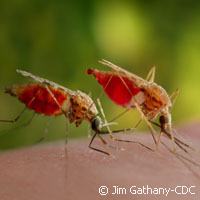Could malarial mosquito species be splitting in two?
The species of mosquito behind most malarial transmission in Africa appears to be splitting into two distinct species, new research reveals. The findings, published in two studies in the journal Science, have serious implications for malaria control efforts, which need to ensure that they are effective against both strains. Meanwhile the scientists underline the importance of monitoring the genetic makeup of different strains of mosquito. Over 200 million people worldwide are infected with malaria, most of them in Africa, where the majority of cases are transmitted by the mosquito Anopheles gambiae. There are two strains of A. gambiae. Dubbed M and S, the two strains are physically identical at all stages of their lives and they can often be found resting in the same houses and flying in the same mating swarms. However, there are some behavioural differences between the strains; for example, the S-form larvae are found mostly in pools of rain water, which are largely free of predators but dry up quickly, while M larvae are more common in more substantial bodies of water which last longer but contain more predators. In the first study, the researchers sequenced the genomes of both strains. This uncovered significant genetic differences between the two strains. The differences are dispersed throughout the genome, leading the scientists to suspect that the genetic differences between the M and S strains may affect the insects' development, feeding behaviour and reproduction. Previous studies had suggested that there were only a few genetic differences between the two strains. The second study saw the researchers map the genetic divergence between the two strains. Their experiments revealed that the M and S strains appear to be evolving differently, and the regions of the genome that are diverging include areas involved in reproduction, longevity, insecticide resistance, aridity tolerance and larval habitat, for example. All in all, the scientists conclude that the genetic differences between the M and S strains are much greater than previously thought and that the speciation process is more advanced than had been suspected. This has major implications for malaria control, as the traits targeted by mosquito eradication programmes, such as feeding behaviour and insecticide susceptibility, may differ between the two strains. 'From our new studies, we can see that mosquitoes are evolving more quickly than we thought and that unfortunately, strategies that might work against one strain of mosquito might not be effective against another,' commented Dr Mara Lawniczak of the UK's Imperial College London and the lead author of one of the papers. 'It's important to identify and monitor these hidden genetic changes in mosquitoes if we are to succeed in bringing malaria under control by targeting mosquitoes.' 'Malaria is a deadly disease that affects millions of people across the world and amongst children in Africa, it causes one in every five deaths,' added Professor George Christophides, also of Imperial College London. 'We know that the best way to reduce the number of people who contract malaria is to control the mosquitoes that carry the disease. Our studies help us to understand the makeup of the mosquitoes that transmit malaria, so that we can find new ways of preventing them from infecting people.'
Countries
Burkina Faso, Cameroon, France, Mali, United Kingdom, United States



